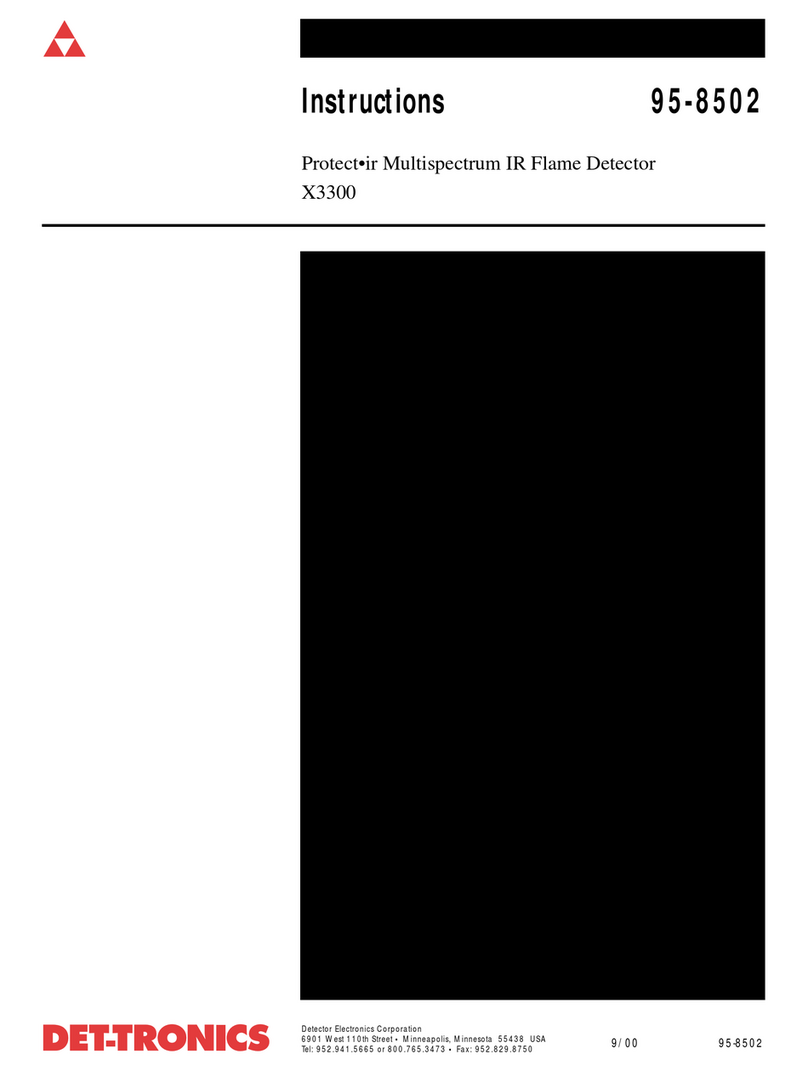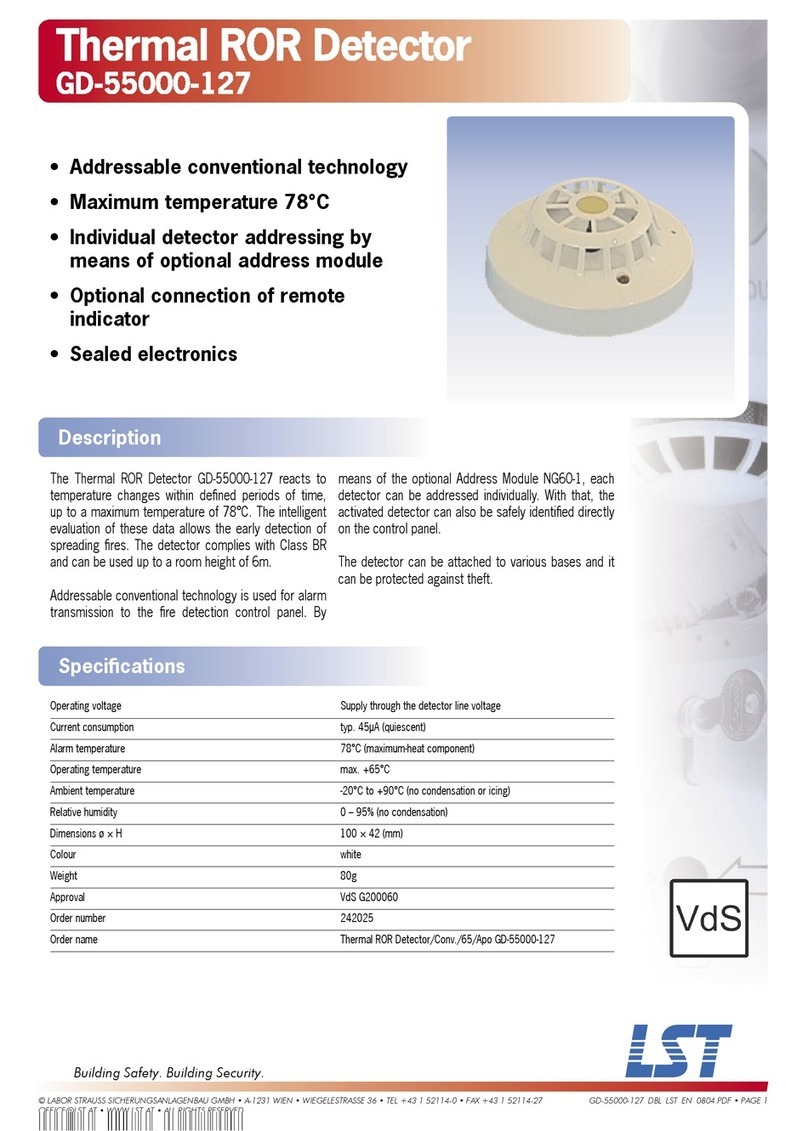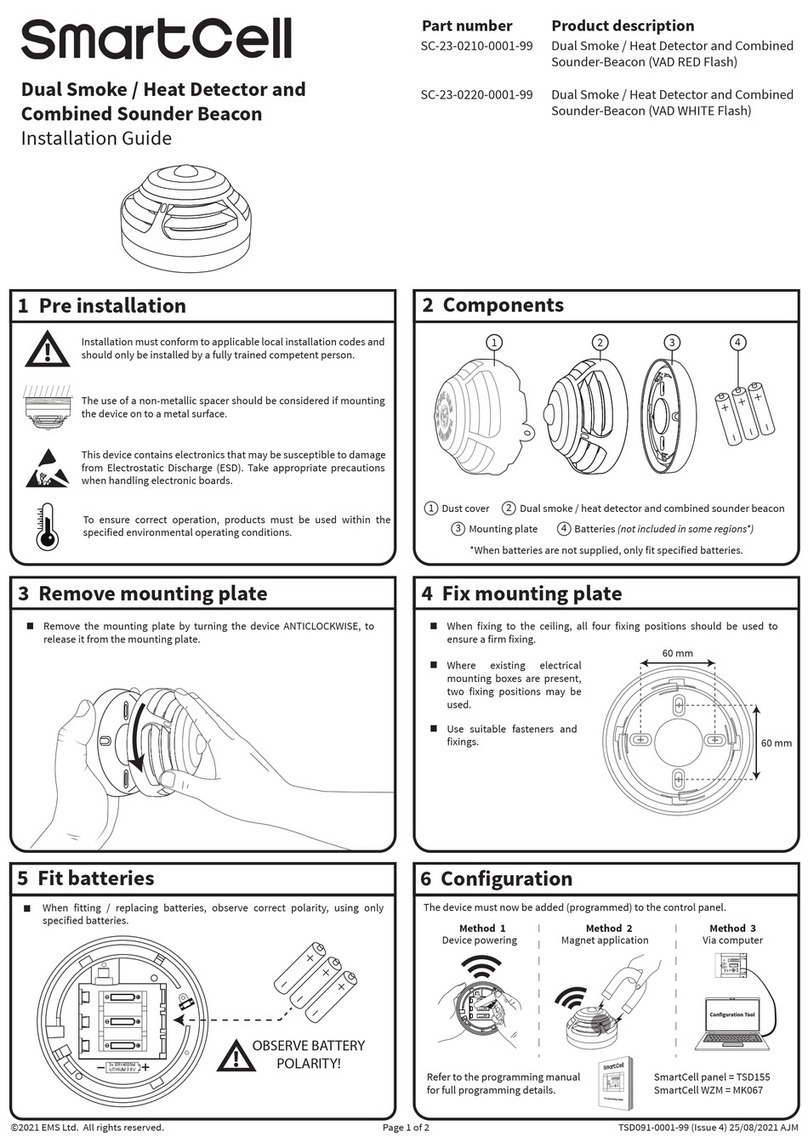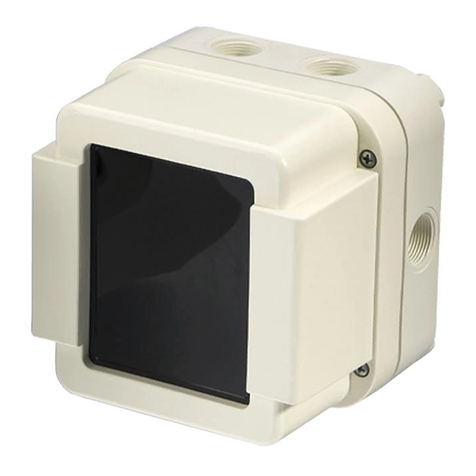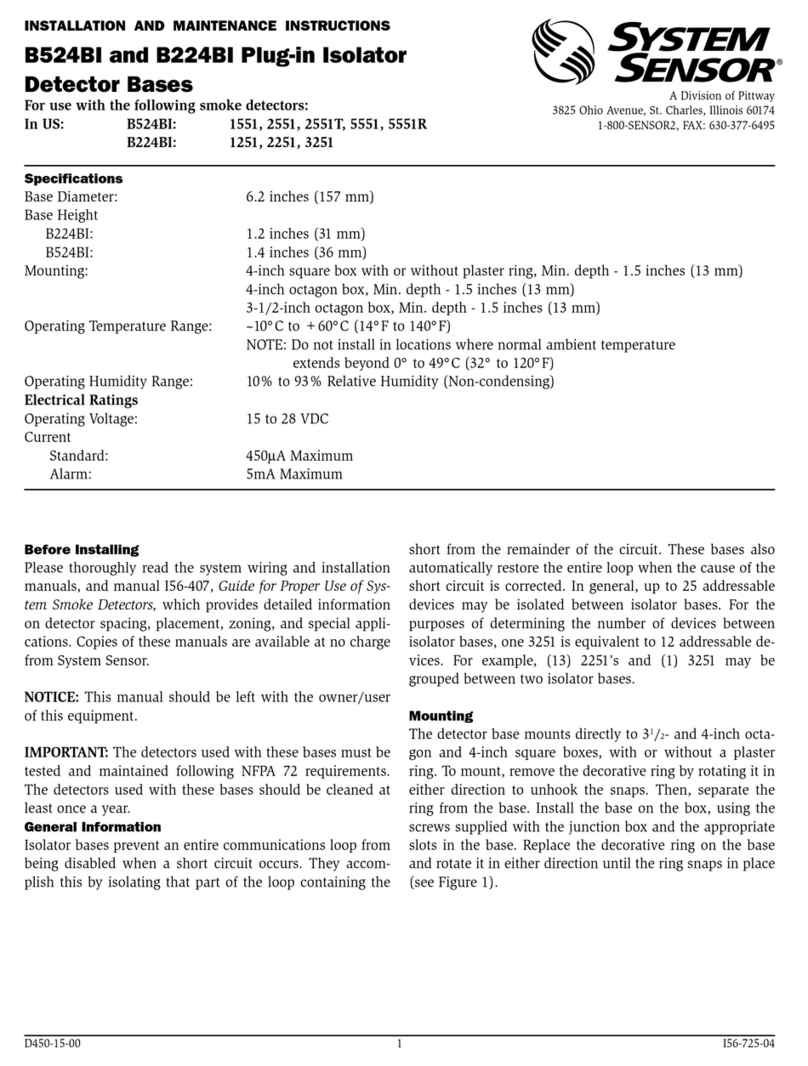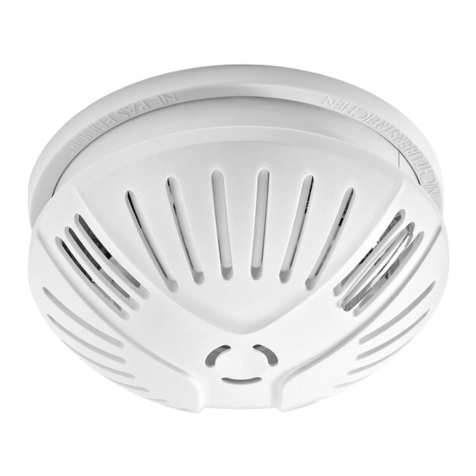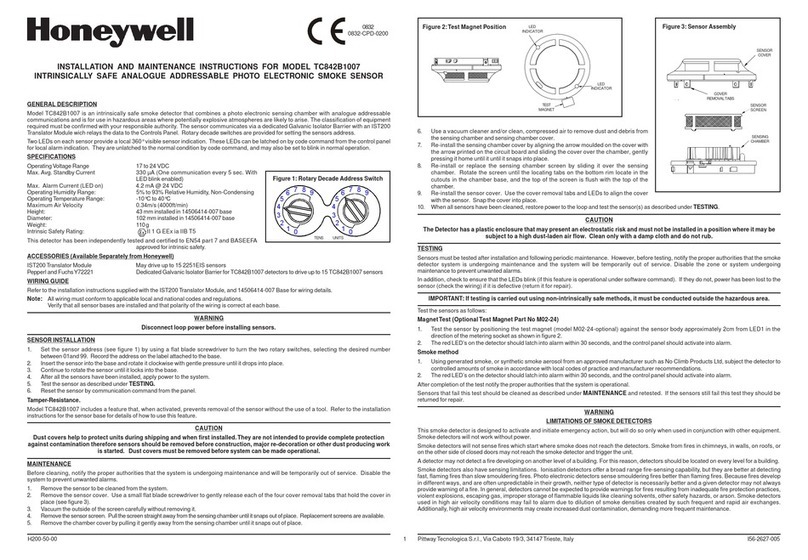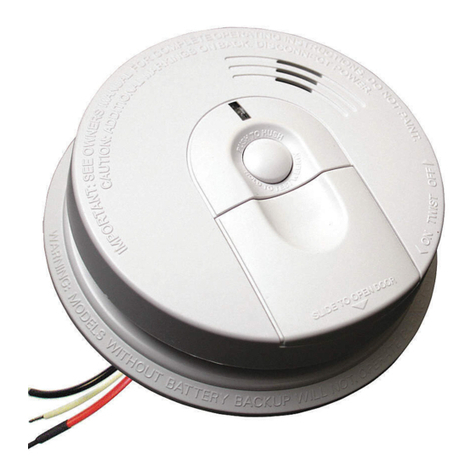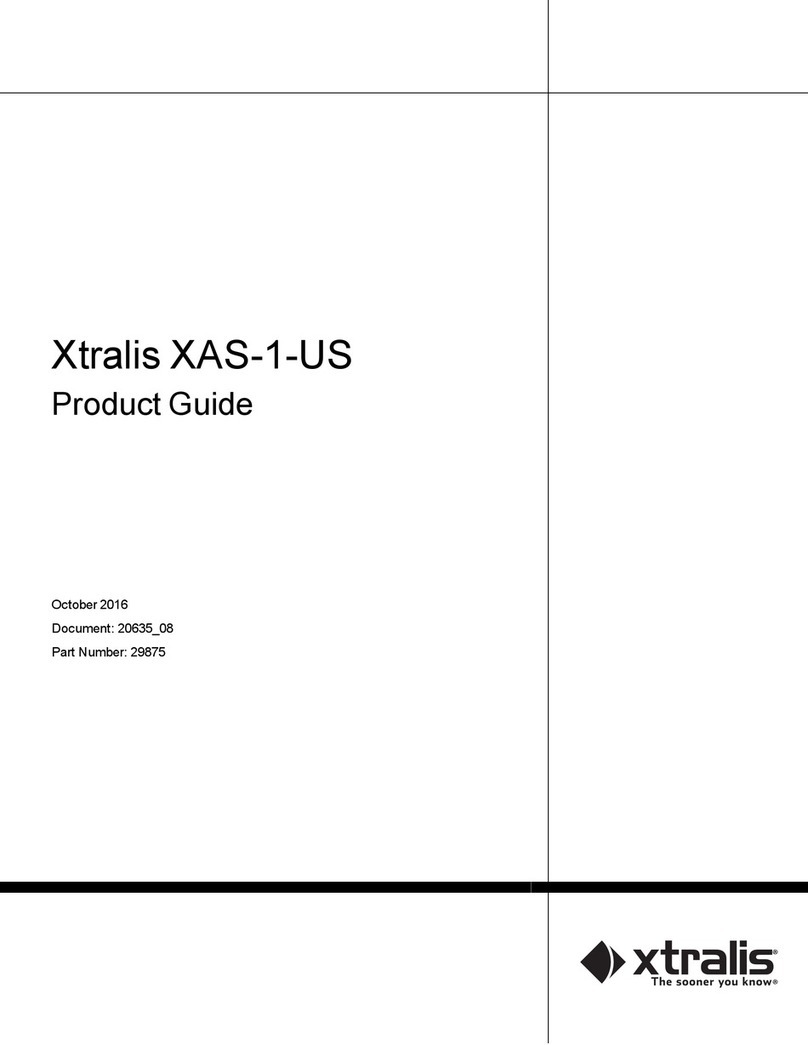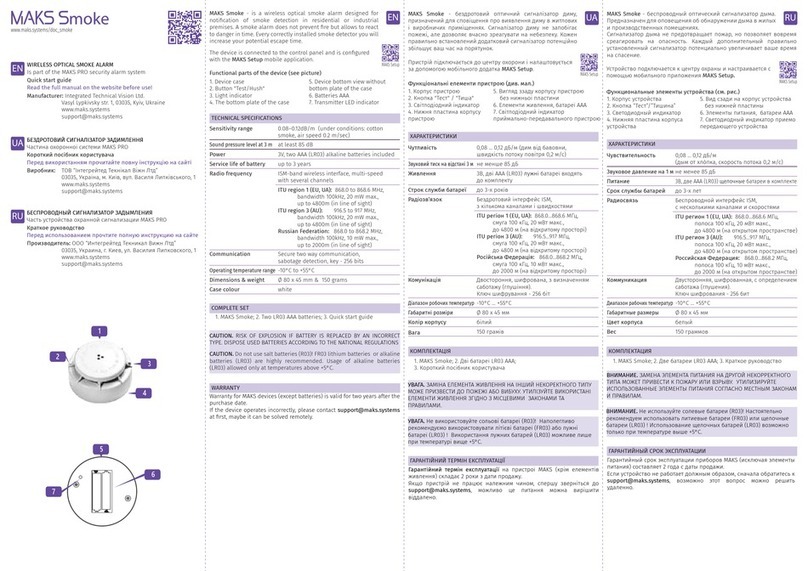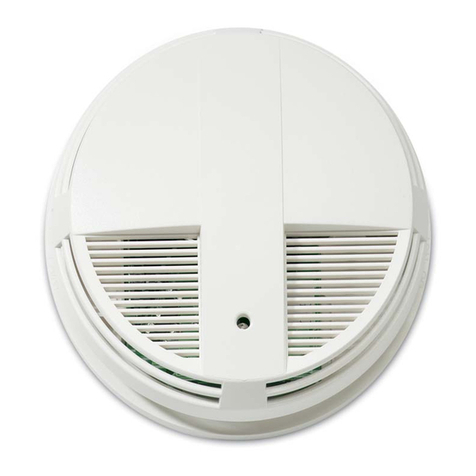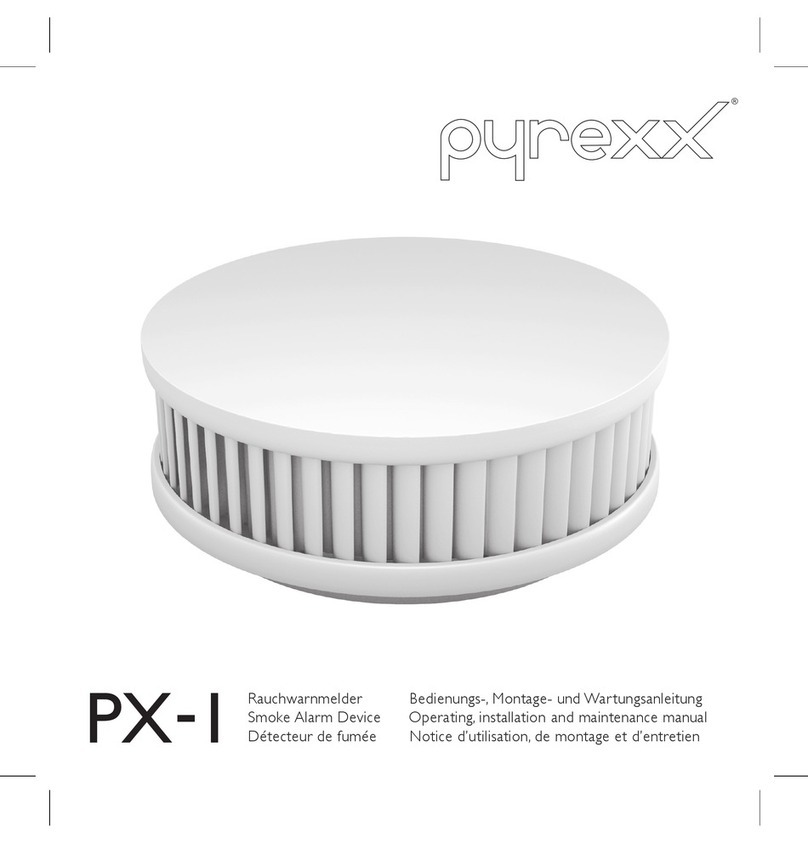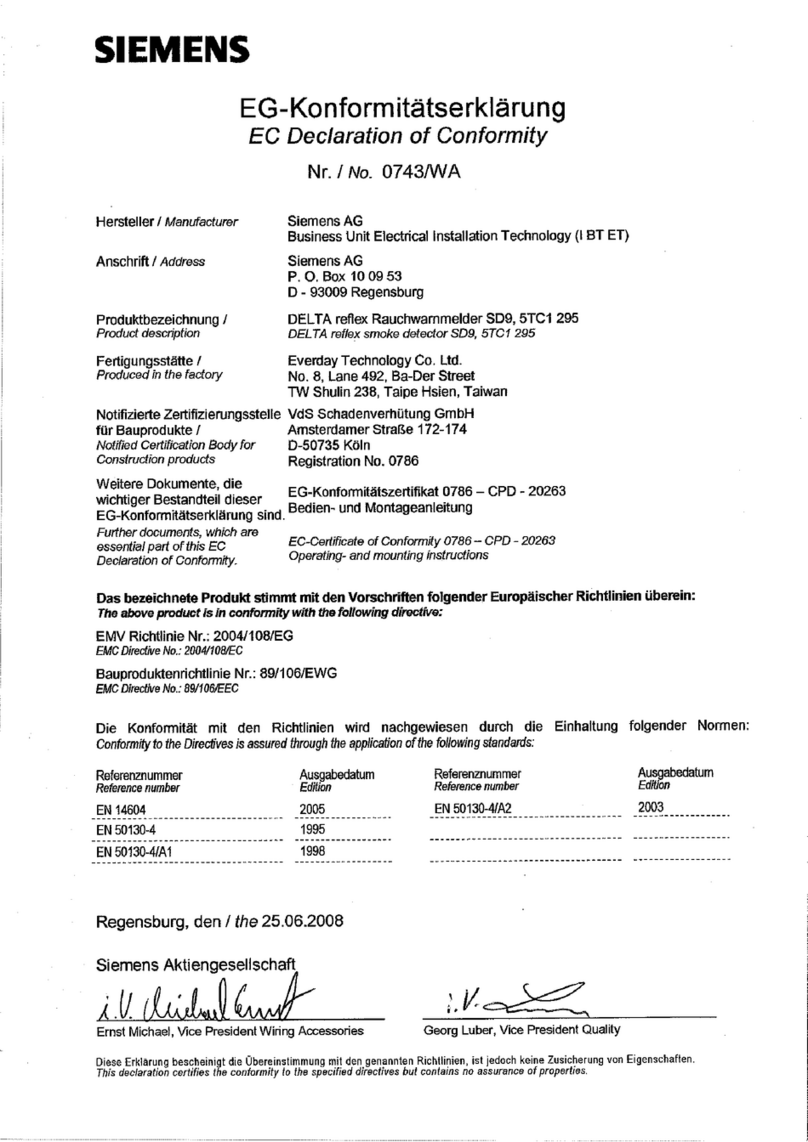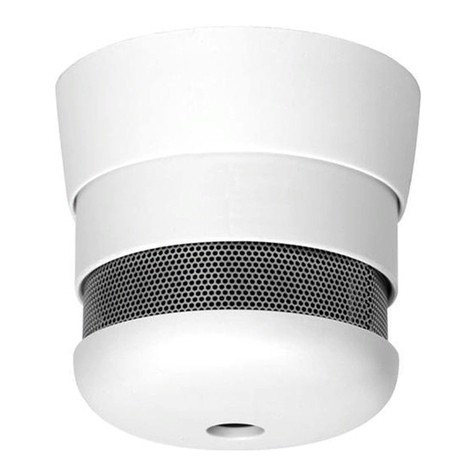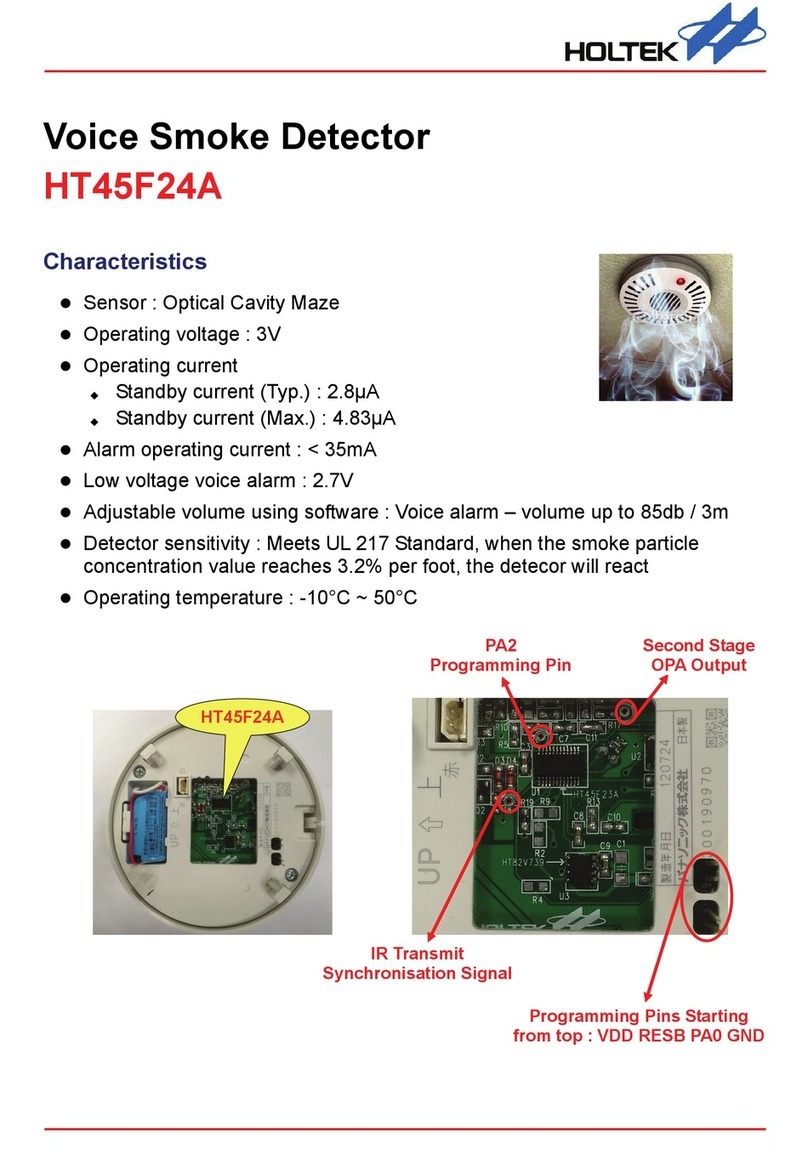Det-Tronics U5005 User manual

APPLICATION
The Det-Tronics U5005 Smoke Detector is a sensitive
yet rugged, state-of-the-art protection device that is
designed for classified areas in hazardous industrial
and commercial locations. The detector is designed
to operate effectively with both slow smoldering and
fast burning fires. Typical applications that use the
U5005 include:
• Combustible storage facilities
• Munitions manufacturing
• Volatile chemical storage
• Chemical processing plants
• Petroleum refineries
• Turbine enclosures.
DESCRIPTION
The photoelectric smoke detector uses a solid state
infrared emitting diode (IRED) and a light sensing
photovoltaic cell arranged in a labyrinth assembly.
The labyrinth permits free access to smoke but
restricts external light. Because of its critical function
to the operation of the detector, each IRED is select-
ed with extreme care and is subjected to rigorous
pre-production testing to ensure long-term reliability
and performance.
During normal operation (no smoke), the detector
samples the air approximately every four seconds for
a period of less than one millisecond. The photo-
voltaic smoke cell, which is placed at an angle to the
pulsed invisible light source, is sensitive to the
infrared light in the specified frequency emitted by
the IRED light source and is designed to receive a
signal only when the pulsed IRED source is activat-
ed. See Figure 1.
When smoke enters the chamber, the light from the
IRED reflects off the smoke particles and reaches the
photovoltaic smoke cell. When the amount of light
reflected by smoke reaches the factory set threshold
level, the smoke alarm circuit is actuated.
The detector will respond to a slow smoldering fire
when smoke in the chamber reaches the pre-set sen-
sitivity setting, typically 2.3%.
If a fast burning fire should occur, including fires in
flammable liquids and other materials such as plas-
tics that generate black smoke, the abnormally rapid
movement of smoke into the detection chamber is
sensed by a special rate compensating circuit. An
increase in smoke within the detection chamber that
exceeds a pre-set rate causes the rate compensation
circuit to increase the intensity of the light source,
which increases detector sensitivity. If the smoke
continues to build at this rate, an amplifier circuit is
triggered and the unit generates an alarm. If not, the
detector reverts to normal sensitivity.
INSTRUCTIONS
Smoke Detector
for Classified Areas
U5005
PHOTOVOLTAIC
SENSOR CELL LENS
IRED
LIGHT
SOURCE
ALARM
LED
LENS
SMOKE CHAMBER B1178
Figure 1—Cross Section of Sensing Chamber Assembly
DET-TRONICS®
©Detector Electronics Corporation 2000 8/00 95-8452-01

In normally smoky atmospheres the detector will not
go into alarm as long as the concentration is less
than the fixed sensitivity of the detector. This results
in a sensitive and positive response with the lowest
potential for unwanted alarms.
The main enclosure of the detector contains the elec-
tronic circuitry, alarm relay, and supervision relay.
FAILSAFE OPERATION
To ensure reliable operation, the U5005 is equipped
with self-checking circuitry. A regulation photodiode,
which is matched to the smoke detection circuit, con-
tinuously monitors the output intensity of the IRED
and adjusts it as necessary to compensate for an
accumulation of dust or other contaminants, or any
other variation that can occur with temperature and
time. A power supervision relay in the detector pro-
vides a trouble output signal in the event of an input
power failure.
The detector uses extensive filtering against RF and
transient interference. In addition, there is a 2 sec-
ond time delay before an alarm is generated.
The printed circuit board inside the detector is coat-
ed to minimize the possibility of problems caused by
moisture accumulation.
DETECTOR OUTPUTS
The detector provides a set of Form A (SPST) NO
contacts for connection to the alarm output circuitry
and a set of SPST NC contacts for supervision of
input power. An auxiliary set of Form C (SPDT)
NO/NC alarm relay contacts is also provided for con-
trolling remote annunciation devices.
The alarm output latches on in the event of an alarm
and an LED located on the outer surface of the hous-
ing is illuminated to provide a visual indication that an
alarm condition has occurred. The detector is reset
by momentarily interrupting input power.
SPECIFICATIONS
OPERATING VOLTAGE—
20 to 28 vdc filtered supply, with less than 1.4 vpp at
60 to 120 Hz.
OPERATING CURRENT—
Standby: 10 milliamperes.
Alarm: 35 milliamperes.
TEMPERATURE RANGE—
Operating: –13°F to +140°F (–25°C to +60°C).
Storage: –67°F to +185°F (–55°C to +85°C).
ALARM AND SUPERVISORY RELAY CONTACT
RATING—
1.0 ampere at 30 vdc, SPST.
AUXILIARY ALARM RELAY CONTACT RATING—
2.0 amperes at 30 vdc, Form C, SPDT.
JUNCTION BOX—
Body material: Copper-free aluminum.
Cover: Feraloy.
Conduit Fitting: 25 mm (female).
CERTIFICATIONS—
CSA Certified for use in Class I, Division 2, Groups A,
B, C and D hazardous locations.
DIMENSIONS—
See Figure 2.
WEIGHT—
2 pounds (0.91 kilogram)
INSTALLATION
The U5005 is intended for surface mounting. See
Figure 2. The mounting screw holes are counter-
bored for No. 8 flat-head screws. Electrical equip-
ment that is used in conjunction with the smoke
detector is connected to the detector using a termi-
nal strip located in the junction box that is furnished
with the unit.
DETECTOR LOCATION
The smoke detector is normally mounted on the ceil-
ing not less than six inches from a side wall. The
exact location of the detector must be determined by
an evaluation based on engineering judgment sup-
plemented, if possible, by field tests.
For additional information on detector location and
spacing, contact the National Fire Protection
Association, Batterymarch Park, Quincy, Mass.
02269, and request a copy of NFPA Number 72, the
Standard on Automatic Fire Detectors.
2

MOUNTING THE DETECTOR
1. Using three No. 8 flat head screws placed through
the counterbored holes in the detector flange,
secure the detector to the surface location. Secure
the junction box if necessary.
2. Remove the cover from the junction box and com-
plete installation of system conduit. Feed the exter-
nal wiring through the remaining junction box entry
or M25 to 3/4 inch adapter. Use care not to dam-
age the wires by twisting them when installing the
junction box.
3. Connect the external wiring to the appropriate ter-
minals and re-install the junction box cover. See
Figures 3, 4 and 5 for wiring details.
DETECTOR CONNECTIONS
The U5005 contains two sets of relay contacts:
1. One set of NO Alarm contacts close upon detec-
tion of smoke.
2. One set of NC Trouble contacts close when the
detector is powered.
3 95-8452
12-3/4 INCHES (325 MM)
8-1/16 INCHES (205 MM)
3-1/2 INCHES
(89 MM)
4-1/2 INCHES
(114 MM)
A1967
120°
5/32 INCH DIA. (3)
2-7/16 INCHES
(62 MM)
5-5/16 INCHES (135 MM)
Figure 2—U5005 Dimensions in Inches (MM)
1
2
3
4
5
NORMALLY CLOSED SUPERVISORY CONTACTS
NORMALLY OPEN ALARM CONTACTS
AUXILIARY ALARM CONTACTS
+
–
GROUND
YELLOW
YELLOW
VIOLET
VIOLET
BLACK
RED
TO DETECTOR
1 2 3 4 5 6 TB – 1
TB – 2
TB – 3
NOTE:
CIRCUIT SHOWN IN THE NORMAL STANDBY ENERGIZED MODE
C1192
7
10
8
9
6
Figure 3—Wiring Terminals

MAINTENANCE
Regularly scheduled maintenance is normally not
needed, however, periodic cleaning of the smoke
chamber may be necessary when detectors are
located in abnormally dirty or dusty environments.
Vacuuming around the smoke chamber housing prior
to blowing out the chamber with a “dry air” hose is
recommended.
NOTE
The U5005 is not designed to be serviced or
repaired in the field. Disassembly of the detector
in the field will void the warranty. If service or
repairs are required, return the entire unit to the
factory.
The smoke detector can be tested using the same
methods employed for any photo-electric detector.
Do not use canned aerosol smoke devices to test the
detector, since damage can result.
DEVICE REPAIR AND RETURN
Prior to returning devices or components, contact
Detector Electronics so that a Service Order number
can be assigned. A written statement describing the
malfunction must accompany the returned device or
component to expedite finding the cause of the fail-
ure. Return all equipment transportation prepaid to
the factory in Minneapolis.
1
2
3
4
5
AUXILIARY ALARM CONTACTS
+
–
C
NO
NC
TB –2
TB –3
POWER
2 WIRE
CLASS B
RECEIVING ZONE
CHASSIS
GROUND
LISTED CONTROL PANEL
+
–EOL DEVICE
SUPPLIED BY
PANEL MANUFACTURER
ADD JUMPER
GROUND STUD
B1193
6
7
8
9
10
Figure 4—Single Detector Wiring
Figure 5—Multiple Detector Wiring
FIRST DETECTOR IN LOOP
TB –2 LAST DETECTOR IN LOOP
TB –2
TB –3
POWER
2 WIRE
CLASS B
RECEIVING ZONE
CHASSIS
GROUND
LISTED CONTROL PANEL
+
–
AUXILIARY
ALARM
CONTACTS
C
NO
NC
AUXILIARY
ALARM
CONTACTS
C
NO
NC
AUXILIARY
ALARM
CONTACTS
C
NO
NC
TB –2
TB –3
1
2
3
4
5
TB –3
EOL DEVICE
SUPPLIED BY
PANEL MANUFACTURER
INSTALL JUMPER
C1696
1
2
3
4
5
1
2
3
4
5
666
777
888
999
10 10 10
Detector Electronics Corporation
6901 West 110th Street • Minneapolis, Minnesota 55438 • Operator (952) 941-5665 or (800) 765-FIRE
Customer Service (952) 946-6491 • Fax (952) 829-8750 • www.detronics.com • E-mail: [email protected]
Other Det-Tronics Smoke Alarm manuals
